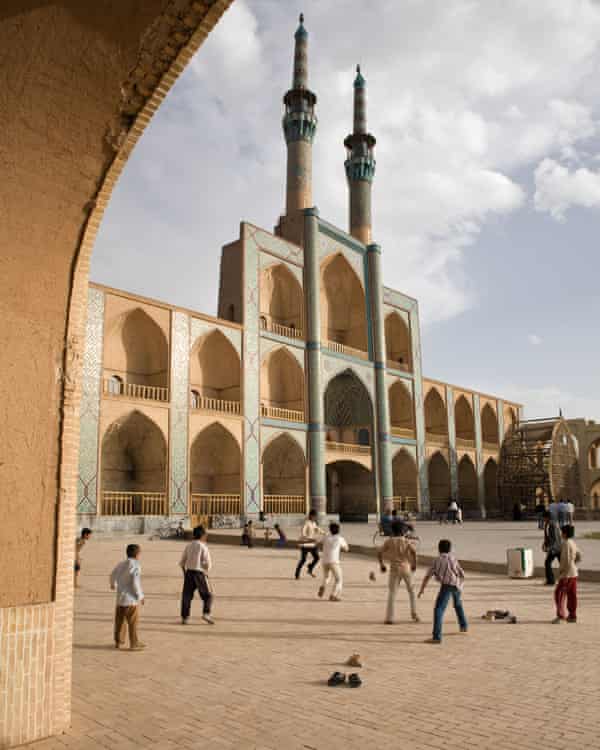[ad_1]
TIt wasn’t a big surprise to her parents. When Shahrzad Mozafar was not playing a ball with her sisters in her sun-drenched family garden in a parched neighborhood in the Iranian province of Khuzestan, she was usually inside, dreaming of the love of her life. Soccer. As an avid viewer of television games – “I’ve loved being a trainer since I was a child” – she once gave in to her fantasies by commenting on an imaginary game and taping every word of the dramatic monologue.
It was an outlet for a sports-loving girl who lived to be eight at the height of the 1978/79 revolution, when newly introduced modesty laws made public sports more difficult for millions of women.
“When my father listened, he loved it,” says Mozafar almost four decades later. Her parents kept the tape for years and eagerly played it back for visitors. Their support sparked the flames of their secret love affair with football – one that led to a transformative career in futsal that made Mozafar a role model for women in the Islamic world of the 21st century.
After doing pioneering work as the coach of the first Iranian women’s soccer team – “It is not easy to be a pioneer of everything that didn’t exist before” – she led the country’s futsal team to the second women’s title of the Asian Football Confederation (AFC) in 2018.
The controversy over the first title three years earlier, with her predecessor Forouzan Soleimani at the helm, made it clear how far we still have to go to equality for women in Iran. The inspiring captain – Niloufar Ardalan, AKA “Lady Goal” – missed the tournament after her husband refused to allow her and insisted that she stay home to accompany her seven year old son on his first day of school. Ardalan’s teammates rallied in their honor and triumphed in all odds, while the standout Fereshteh Karimi shone in Ardalan’s No. 7 jersey.
Shortly after Mozafar’s team retained the title, the economic sanctions imposed by the new US President Donald Trump hit Iranian sport hard and triggered an exodus, to which Mozafar moved to Kuwait as head coach of the women’s futsal team.
In 2019, she proudly sat as the only female coach in Fifa and the AFC and advocated women’s football from within.
Her life traces the course of sports history in a country that stands for conflicts between belief and culture. And her trip also underscores the special role of futsal – the indoor game sanctioned by FIFA – in the stubborn rise of women’s sport in the Muslim world.
For Mozafar, the resistance it symbolizes began early. “The passion was born with me,†she says. “I’ve been looking for a ball all my life. I can remember seeing the 1982 World Cup in Spain. I cried all night when Brazil lost to Italy. “
She wasn’t alone. A more collective form of defiance removed a huge barrier for women in 1993, a little over a decade after the political earthquake ousted the Shah. The game changers were the sports-loving students from Alzahra University in Tehran, the only all-female university in the country. With an increasing number of women in education in the Islamic Republic, students forced the university administration to allow a groundbreaking unofficial futsal tournament in which nine other college teams participated.
It was nothing short of a cultural revolution. Just like Mozafar, the game was stolen from many of the women as children after girls took to the streets alongside boys in the early 1970s. The Alzahra students decided that enough was enough.
By 1997, the powerful physical education organization had formed a futsal committee that eventually approved an official women’s university futsal competition in which more than 100 students participated in 12 teams.
“For the authorities, futsal was a palatable solution for women,†writes Timothy F. Grainey in his book Beyond Bend it Like Beckham: The Global Phenomenon of Women’s Soccer. “You could play in an indoor facility where men could easily get locked out. That way, university officials and gamers didn’t break Sharia law. “
It was a lifetime for Mozafar to overcome obstacles in a nation where football and futsal were banned from ages eight to 28.

Her experience with the Iranian national sport in street football, gol koochik, which means small goal in Persian, brought despair and hope in equal measure. The revolution stopped their game, but it didn’t stop Gol Koochik. “Lots of guys played,†she says. “At that time, the big cities in Iran weren’t too crowded. They built a gate with bricks or stones and sometimes used parked cars as a gate. If the ball went under the car, it was the goal.
“The plastic ball they played with was made for children … actually it was a toy. Since it was very light, they cut it with a knife to make a slit, then put another one in it to make it hard and call it two-ply ball. They played two against two, three against three, four against four etc. They had a lot of spectators, including me.
But watching wasn’t enough. She longed for games. And when her family moved to Tehran for safety at the height of the war, she found a outlet in volleyball – and another refuge. After representing the national team for a decade from the age of 18, she quit volleyball when futsal took off – and was aware that at 29 she was too old to start a new life as a player.
Coaching beckons. In the early 2000s – “We didn’t have football, just futsal” – she immersed herself in tactics as the head coach of various clubs and assisted the coach of the new women’s futsal team.
At the time, the Iranian men’s team was struggling to earn the title of “Kings of Asian Futsal” by winning the first AFC tournament in 1999 – the first of seven titles in a row.

In 2005, Mozafar was nearing its own crossroads. Khadejeh Sepanji, head of women’s football in the Iranian Football Association, invited her to lead the new national football team at the West Asian Football Games. “I was 35, I didn’t have a football coaching background, and there wasn’t a football league,†says Mozafar. “In other words, we didn’t have soccer players.”
With just a few weeks to put together a squad, she followed instinct and recruited futsal players. “They couldn’t even do long and high passes because they had never played on grass before,” she says. But they made it to the games and finished second behind hosts Jordan.
“That was the beginning of football in my country,†she says. For the next five years she combined club futsal with national football duties before being instructed by the association to choose between the two sports. It wasn’t a difficult decision.
“Iran was a pioneer in futsal in Asia,” she says, while lagging behind its Asian rivals in football. “So I decided to focus on futsal and make my dreams come true.”
This is an edited excerpt from Jamie Fahey’s book Futsal, the Story of an Indoor Football Revolution (Melville House UK), which has now been published with a foreword by Roberto MartÃnez.
[ad_2]

